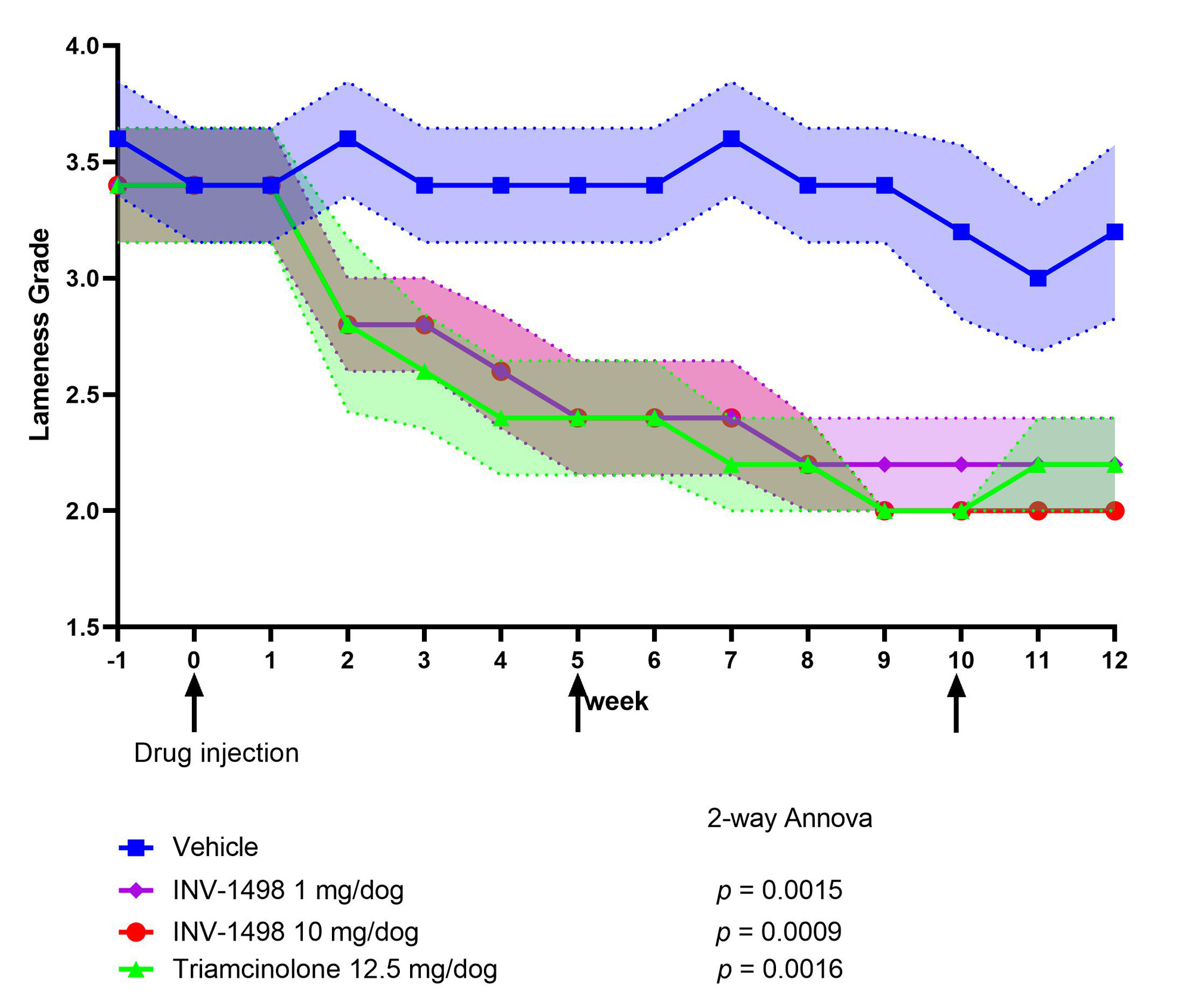Session Information
Date: Monday, November 13, 2023
Title: (0859–0885) Osteoarthritis & Joint Biology – Basic Science Poster
Session Type: Poster Session B
Session Time: 9:00AM-11:00AM
Background/Purpose: Osteoarthritis poses a substantial medical challenge, as the available treatments primarily target symptom relief and fail to effectively halt the progressive cartilage deterioration that ultimately leads to joint replacement. Addressing this therapeutic gap, the development of interventions capable of preventing or slowing down the progression of osteoarthritis is imperative. This study unveils INV-1498 as an advanced late pre-clinical candidate that exhibits noteworthy, dose-dependent effects on joint structure, function, and pain, offering a promising avenue for addressing osteoarthritis.
Methods: A total of thirty-five purpose-bred dogs were selected for this study. Prior to surgery, the knees of each animal were shaved and the animals were anesthetized. Anterior cruciate ligament resection and excision of the medial meniscus were performed, followed by wound closure. Antibiotics and analgesics were administered for 7 days post-surgery. One week after surgery, the animals underwent artificial exercise for 14 days, with daily sessions lasting 30 minutes. The experimental groups received different doses of the study product (10 mg, 1 mg, or 1 mg in a 1 mL volume) every 5 weeks, while one group received a single 10 mg dose. Triamcinolone 12.5 mg was administered intra-articularly every 5 weeks as an active comparator. After 14 weeks, a CT scan of the knee joint was performed. Pain assessment was conducted throughout the study using the LAMNESS GRADE scale (0-4). At 15 weeks post-osteoarthritis (OA) induction, the dogs were euthanized, and a comprehensive macroscopic evaluation of the operated knee joint was conducted. Tissue sections were prepared and stained with H&E and Safranin O for blinded OARSI histologic scoring.
Results: In the gait assessment, all doses of INV-1498, including the highest dose (10 mg, p=0.0009), exhibited significant improvements, indicating reduced pain. Although there was no statistical significance between doses, a dose-dependent trend of improvement was observed (Figure 1). Analysis of joint structure by CT scan revealed significant improvement only in the highest dose group (10 mg, p=0.0135). Histopathologic evaluation, using the OARSI histopathology method, demonstrated that the highest dose of INV-1498 (10 mg, p=0.0021) significantly reduced proteoglycans, chondrocytes (p=0.0109), and femur-layer lining cells (10 mg, p=0.025). Although not statistically significant, synovial membrane hyperplasia and inflammation tended to be reduced in the INV-1498 group compared to the control group (Figure 2).
Conclusion: Taken together, these data provide compelling evidence of the efficacy of INV-1498 in controlling osteoarthritis progression and symptoms. We found that even a dosing scheme of every 5 weeks prevented the most important pathophysiological changes that promote osteoarthritis progression. These findings position INV-1498 as a highly promising candidate for clinical development as a disease-modifying therapy for osteoarthritis, offering the additional benefit of pain reduction.
To cite this abstract in AMA style:
Park J, Lee Y, Park J, Kim m. INV-1498, a Promising Caspase Inhibitor, Exhibits Dose-dependent Therapeutic Efficacy in a Canine Model of Osteoarthritis [abstract]. Arthritis Rheumatol. 2023; 75 (suppl 9). https://acrabstracts.org/abstract/inv-1498-a-promising-caspase-inhibitor-exhibits-dose-dependent-therapeutic-efficacy-in-a-canine-model-of-osteoarthritis/. Accessed .« Back to ACR Convergence 2023
ACR Meeting Abstracts - https://acrabstracts.org/abstract/inv-1498-a-promising-caspase-inhibitor-exhibits-dose-dependent-therapeutic-efficacy-in-a-canine-model-of-osteoarthritis/


